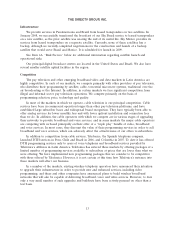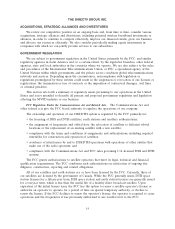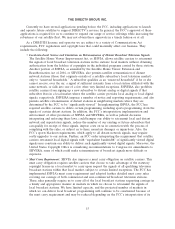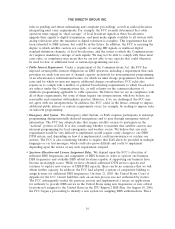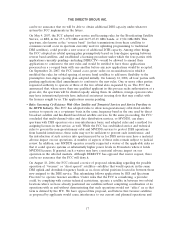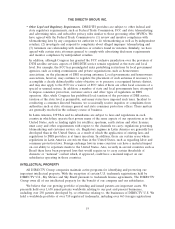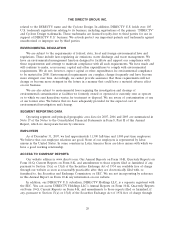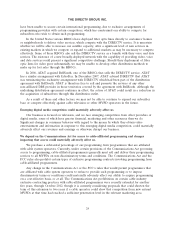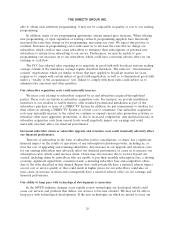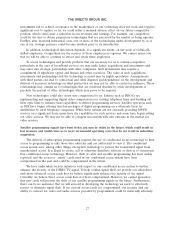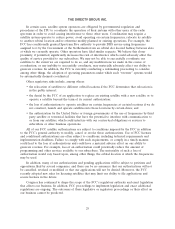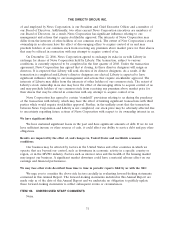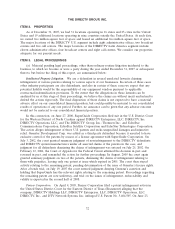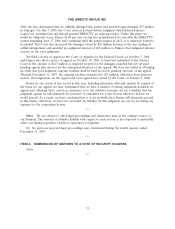DIRECTV 2007 Annual Report Download - page 32
Download and view the complete annual report
Please find page 32 of the 2007 DIRECTV annual report below. You can navigate through the pages in the report by either clicking on the pages listed below, or by using the keyword search tool below to find specific information within the annual report.THE DIRECTV GROUP, INC.
The cost of commercial insurance coverage on our satellites or the loss of a satellite that is not
insured could materially adversely affect our earnings.
We use in-orbit and launch insurance to mitigate the potential financial impact of satellite fleet
in-orbit and launch failures unless the premium costs are considered uneconomic relative to the risk of
satellite failure. When insurance is obtained, it generally covers all or a portion of the unamortized
book value of covered satellites. Although the insurance does not compensate for business interruption
or loss of future revenues or subscribers, we rely on in-orbit spare satellites and excess transponder
capacity at key orbital slots to mitigate the impact that a satellite failure may have on our ability to
provide service.
The price, terms and availability of insurance fluctuate significantly. Launch and in-orbit policies
on satellites may not continue to be available on commercially reasonable terms or at all. In addition to
higher premiums, insurance policies may provide for higher deductibles, shorter coverage periods and
satellite health-related policy exclusions.
Any launch vehicle failure, or loss or destruction of any of our satellites, even if insured, could
have a material adverse effect on our financial condition and results of operations, our ability to
comply with FCC regulatory obligations and our ability to fund the construction or acquisition of
replacement satellites in a timely fashion, or at all.
We compete with other MVPDs, some of whom have greater resources than we do and levels of
competition are increasing.
We compete in the MVPD industry against cable television, RBOCs, wireless companies and other
land-based and satellite-based system operators with service offerings including video, audio and
interactive programming, data and other entertainment services and telephony service. Some of these
competitors have greater financial, marketing and other resources than we do.
Some cable television operators have large, established customer bases and many cable operators
have significant investments in, and access to, programming. According to the National Cable &
Telecommunications Association’s 2007 Industry Overview, 100% of the 112 million U.S. television
households are passed by cable. Of the 112 million U.S. television households, approximately 97 million
subscribe to a MVPD service and approximately 66% of MVPD subscribers receive their programming
from a cable operator. Cable television operators have advantages relative to us, including or as a
result of:
• being the incumbent MVPD operator with an established subscriber base in the territories in
which we compete;
• bundling their analog video service with expanded digital video services delivered terrestrially or
via satellite, or with efficient two-way high-speed Internet access or telephone service on
upgraded cable systems; and
• having the ability to provide certain local and other programming, including HD programming,
in a larger number of geographic areas.
In addition, cable television operators have grown their subscriber bases through mergers and
acquisitions. Moreover, mergers, joint ventures and alliances among franchise, wireless or private cable
television operators, RBOCs, and others may result in providers capable of offering bundled television,
data and telecommunications services in competition with our services.
We do not currently offer local channel coverage to markets covering approximately six percent of
U.S. television households, which places us at a competitive disadvantage in those markets. We also
23


